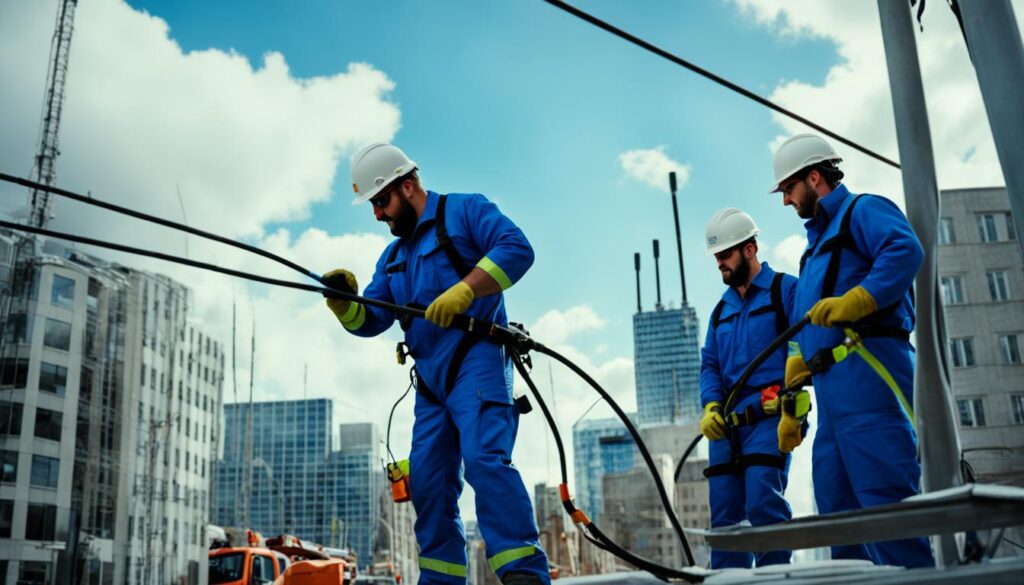When it comes to outdoor cable installation, crossing a pathway can present unique challenges. However, with the right techniques and proper cable management, you can ensure a safe and efficient installation. In this article, I will provide you with valuable insights on how to get electrical cable over a pathway while prioritizing safety and implementing effective routing solutions.
Key Takeaways:
- Plan and carry out a thorough risk assessment to identify potential hazards and minimize risks.
- Obtain cable plans and use cable locating devices to ensure there are no underground cables in the pathway.
- Follow safe digging practices and use insulated tools near electric cables to prevent damage or accidents.
- Stay informed about general electrical information and resources provided by organizations such as the Health and Safety Executive (HSE) and the Electricity Networks Association (ENA).
- Proper cable management and route planning are essential for a successful installation.
Understanding the Risks of Underground Cables
When it comes to underground cables, it’s important to understand the potential risks they pose. Damaged underground cables can lead to electric shocks, explosions, and severe burns, even if protective clothing is worn. The Health and Safety Executive (HSE) highlights that cables can be cut through or crushed by sharp or heavy objects, resulting in dangerous incidents.
To mitigate these risks, proper cable management is crucial. By following the guidance provided by the HSE on “Avoiding danger from underground services,” individuals and organizations can effectively manage the risks associated with digging near underground cables. This valuable information emphasizes the importance of understanding and implementing safety measures to prevent accidents and injuries.
The Electricity Networks Association (ENA) also provides helpful advice through its publication, “Watch It! When digging in the vicinity of underground electric cables.” This resource offers additional insights and recommendations for managing cable damage risks to ensure the safety of both individuals and the cables themselves.
It is essential to prioritize the safety of workers, pedestrians, and property when dealing with underground cables. Implementing proper cable management practices is not only necessary for avoiding potential dangers but also essential for maintaining the integrity of the electrical infrastructure.
Important Considerations:
- Electric shocks, explosions, and burns can occur even with protective clothing.
- Sharp or heavy objects can cut through or crush underground cables.
- Proper cable management is essential for avoiding danger and potential incidents.
Remember, to ensure safety and prevent cable damage, it is crucial to follow the guidelines provided by the HSE and ENA in their comprehensive resources on managing risks when working with underground cables.
Managing the Risks of Excavation Work
Excavation work near underground cables requires careful planning and risk management. It is essential to prioritize safety and minimize potential hazards during the excavation process. To effectively manage excavation work risks, the following steps should be taken:
- Identify ownership and consult relevant organizations: Before starting any excavation work, it is crucial to determine the ownership of the service cables and consult the appropriate organizations. They can provide valuable information and cable plans that will help in accurate location confirmation.
- Engage experienced professionals: Excavating near your own cables requires the assistance of individuals experienced in underground cable detection techniques. These experts possess the knowledge and skills to detect and navigate around underground cables, minimizing the risk of damage.
- Consider local circumstances: Every excavation project is unique, so it’s important to consider local circumstances such as soil conditions, the presence of other utilities, and potential environmental factors. This will help in devising a comprehensive excavation plan that accounts for possible risks.
- Use cable plans as a guide: Cable plans provide crucial information on the layout and location of underground cables. By using these plans as a guide, excavation work can be carried out with precision, avoiding the risk of accidental damage to cables.
- Employ suitable locating devices: Tracing cables during excavation is of utmost importance. Suitable locating devices should be used to accurately identify the location and path of underground cables. These devices help prevent accidental damage and ensure safe excavation practices.
- Follow recognized safe digging practices: Excavation work must adhere to recognized safe digging practices to minimize risks. These practices include using appropriate excavating techniques, employing insulated tools near electric cables, and maintaining a safe working distance from underground cables.
By following these guidelines, managing excavation work risks becomes more efficient and effective. Prioritizing safety and using proper planning and detection techniques greatly reduces the possibility of damaging underground cables during excavation work, ensuring a safer and smoother construction process.

Image: Excavation work near underground cables requires careful planning and risk management.
Tools for Tracing Electrical Wiring
Tracing electrical wiring behind walls can be made easier and more efficient with the use of various tools specifically designed for this purpose. These tools enable electricians and DIY enthusiasts to locate and identify electrical wiring without the need for extensive demolition or guesswork. Here are some of the most commonly used tools for tracing electrical wiring:
1. Stud Finders:
Stud finders are versatile tools that can detect the presence of metal nails or screws embedded in wall studs. While their primary purpose is to locate studs for hanging objects, they can also detect denser regions of the wall, indicating the possible presence of electrical wiring.
2. Voltage Detectors:
Voltage detectors are essential tools for testing whether electrical wires are live or not. They come in various types, including neon-bulb versions and audible alarm detectors. These tools provide quick and reliable indications of live wires, helping to prevent accidental electric shocks during wiring troubleshooting or installation.
3. Tone Generator:
A tone generator is a valuable tool for identifying specific wires within a bundle or conduit. By sending out a high-frequency signal, it allows the user to trace the path of a particular wire using a receiver. This can be particularly useful in complex wiring systems or when dealing with multiple circuits.
4. Circuit and Wire Tracers:
For more advanced tracing tasks, circuit and wire tracers can be employed. These specialized tools are designed specifically for locating and tracing electrical wiring. They provide accurate and detailed information about the wiring layout, circuit continuity, and even the depth of wires behind walls or under floors. However, it is important to note that these tools tend to be more expensive and may require some level of expertise to operate effectively.
By utilizing these tools, electricians and DIY enthusiasts can confidently trace electrical wiring, saving time, effort, and unnecessary damage to walls or other structures. Whether it’s locating a wiring route or troubleshooting a faulty circuit, these tools play a crucial role in successful electrical projects.
Note: Always exercise caution and follow proper safety guidelines when working with electricity. If you are unsure about any wiring or electrical-related task, it is recommended to consult a qualified professional.
Safety Precautions while Working near Overhead Power Lines
Working near overhead power lines can be extremely dangerous if proper safety precautions are not taken. Accidental contact or close proximity to live overhead power lines can result in serious injuries or even fatalities. Therefore, it is crucial to prioritize safety and adhere to specific guidelines to mitigate the risks associated with working near overhead power lines.
Determining the location: Before commencing any work, it is essential to identify the location of overhead power lines in the vicinity. This can be done by consulting the relevant authorities or owners of the power lines. Knowing the exact position of the power lines will help in planning the work and taking appropriate safety measures.
Eliminating danger: To ensure safety, it is important to avoid working directly beneath or near live overhead power lines whenever possible. If work is necessary in close proximity to power lines, it might be possible to divert or isolate the lines by coordinating with the respective authorities. This helps in reducing the risks associated with accidental contact or electrical hazards.
Controlling access: Access to and work beneath live power lines should be strictly controlled to prevent unauthorized entry or accidental contact. This can be achieved by installing barriers, goal posts, or other designated passageways that clearly indicate restricted areas. Ensuring clear signage and providing thorough training to workers regarding the dangers of working near power lines can also contribute to maintaining safety.
Verifying circuit status: It is crucial to verify whether a circuit is live or has been turned off before making any modifications or performing electrical work. The use of voltage detectors is essential to determine the presence of electrical current. Workers should always follow proper procedures and protocols to ensure that circuits are de-energized and safe to work on.

In summary, working near overhead power lines requires strict adherence to safety precautions to protect workers from potential hazards. By determining the location of power lines, eliminating danger through diversion or isolation, controlling access, and verifying circuit status using voltage detectors, the risk of accidents and injuries can be significantly reduced.
What to Do in Case of Contact with an Overhead Power Line
In the unfortunate event of contact with an overhead power line, it is important to follow emergency procedures. Here are the steps you should take:
- Remain in the vehicle: If contact occurs while inside a vehicle, it is crucial to stay inside. Do not attempt to leave the vehicle as the ground may become energized.
- Inform the Distribution Network Operator (DNO): Immediately contact the DNO and provide them with details of the incident. They are responsible for managing the distribution of electricity and can take the necessary steps to address the situation.
- Warn others: If there are people nearby, warn them to stay away from the vehicle and the power line. It is important to prevent others from coming into contact with the live wires.
- Drive clear of the line: If it is safe to do so, try to drive the vehicle clear of the power line. Move away from the area to a safe location where you can wait for assistance.
- Do not climb down: Avoid the temptation to climb down from the vehicle using the steps. In case of immediate danger, jump clear of the vehicle, making sure to land with both feet together to avoid potential differences in voltage.
It is important to note that contact with an overhead power line may cause the power to trip out temporarily and then be re-energized automatically. Therefore, even if the power appears to be off, exercise caution and treat the line as live until it has been confirmed by qualified personnel.
For additional safety, consider obtaining stickers with emergency procedures and contact numbers from your Distribution Network Operator. These can be placed in vehicles or on equipment to provide a quick reference in case of an incident.
Additional Resources for Electrical Safety
In addition to the information provided by the Health and Safety Executive (HSE) and the Electricity Networks Association (ENA), there are various organizations that offer valuable resources on electrical safety. These resources provide general electrical information and guidance on working with electricity, as well as access to accident statistics that can help understand the risks associated with electrical work.
The HSE offers a priced interactive CD and web pages that provide simple precautions and frequently asked questions on working with electricity. These resources are designed to educate individuals and promote safe practices in electrical work. Taking the time to familiarize yourself with these resources can greatly enhance your knowledge and understanding of electrical safety.
Other organizations also offer valuable information and guidance on electrical matters. From online tutorials to instructional videos, these resources offer practical tips and helpful insights to ensure safe electrical practices. They provide guidance on various aspects of working with electricity, including installation, maintenance, and troubleshooting.
Accident statistics play a crucial role in understanding the risks associated with electrical work. By analyzing accident data, one can identify common hazards and develop strategies to mitigate them. These statistics help raise awareness and reinforce the importance of safety precautions in electrical work.
Below is an example of accident statistics in the UK related to electrical incidents:
| Year | Total Electrical Incidents | Fatalities | Injuries |
|---|---|---|---|
| 2016 | 830 | 18 | 725 |
| 2017 | 795 | 14 | 672 |
| 2018 | 820 | 16 | 705 |
Understanding these statistics can help individuals and organizations assess the risks involved in electrical work and take appropriate measures to prevent accidents and injuries.
Conclusion
Safely getting electrical cables over a pathway requires proper planning, risk management, and the use of appropriate tools. By following the guidelines provided by the Health and Safety Executive (HSE) and the Electricity Networks Association (ENA), individuals can ensure the safety of both themselves and the cables during outdoor cable installation.
When tracing and identifying electrical wiring behind walls, tools such as stud finders, voltage detectors, tone generators, and circuit tracers can be invaluable. These tools help simplify the process and ensure accurate identification, contributing to efficient and safe cable installation.
It is crucial to prioritize safety when working near overhead power lines. Proper safety precautions, including voltage detection and avoiding contact with live lines, must be taken. Additionally, individuals should familiarize themselves with emergency procedures and contact the Distribution Network Operator (DNO) immediately in case of contact with an overhead power line.
By adhering to the recommended practices and utilizing available resources, individuals can successfully navigate the challenges of cable installation over a pathway. Prioritizing safety, implementing pathway cable management best practices, and utilizing electrical cable pathway solutions contribute to a safe and effective outdoor cable installation process.









